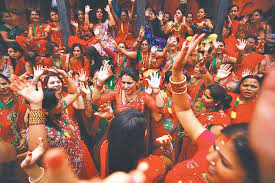
Teej is a significant Hindu festival celebrated by women mainly in Nepal and some parts of India. The festival is dedicated to Goddess Parvati and her union with Lord Shiva. It typically falls in the monsoon months of July-August or Shrawan-Bhadra according to the Hindu lunar calendar.
Teej is primarily celebrated by women, for the wellness of their husbands and their family. Unmarried women also observe this festival with the hope of being blessed with a good husband. Women dress up in red, which is considered auspicious and symbolic of marriage in Hindu culture. They adorn themselves with beautiful jewelry and apply henna (mehendi) on their hands.
The festival lasts for three days, involving various rituals and rites:
- First Day (Dar Khane Din): On this day, women gather at a place, sing traditional songs, and dance. A feast known as “Dar” takes place on this day, and it’s the grand one as the next day women will be fasting. It is the only day in the year that the women of the house eat their meal first before the rest of the family.
- Second Day (Fasting): This is the fasting day. Some women observe a rigorous fast where they don’t even drink water, while others might observe a light fast. The fasting is symbolic of devotion to Lord Shiva and Goddess Parvati. The fast is broken the next day after offering prayers to the gods.
- Third Day (Rishi Panchami): On this day, women pay homage to seven saints or sages (Saptarshi) and various deities, and perform a purification ritual.
The festival of Teej signifies women’s love and sacrifice. It’s a celebration of the victory of a wife’s love and devotion towards her husband, symbolized by the mythical union of Lord Shiva and Goddess Parvati, after she fasted and prayed devoutly for his love and attention.
